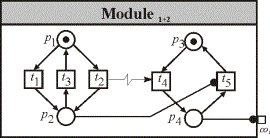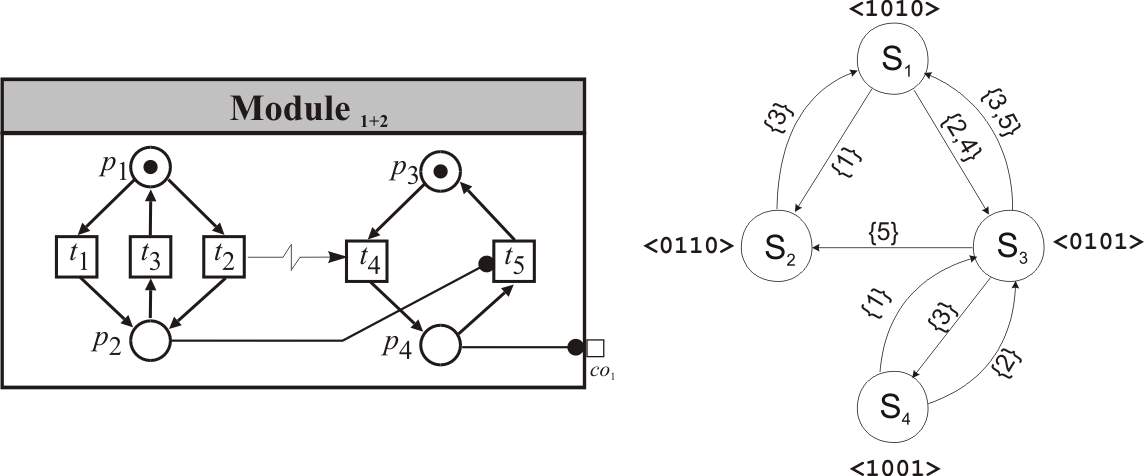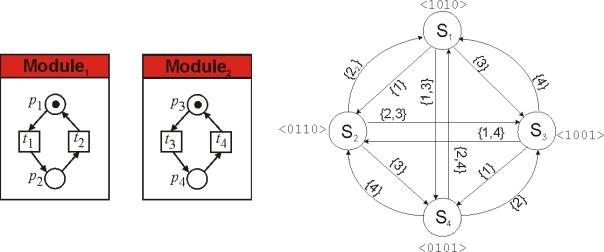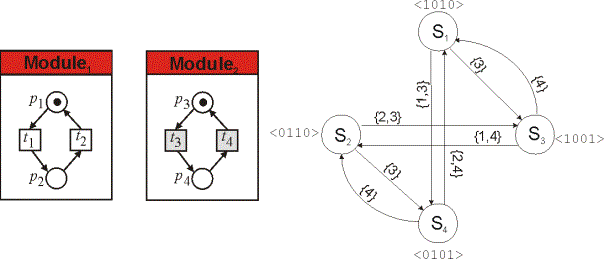
Net Condition/Event
Systems having no inputs are called Signal/Event nets (S/E nets). The model in
Figure 1 is a S/E net.

Figure 1.
A signal/event net.
S/E
net can be analyzed without any additional information about their external
environment. The semantics of Signal/Event nets is defined by the firing rules
of transitions. There are several conditions to be fulfilled to enable a
transition to fire.
First,
as it is in ordinary Petri nets, an enabled transition has to have a token
concession. That means that all pre-places have to be marked with at least one
token[1].

Figure 2.
Token concession of transition
In
addition to the flow arcs from places, a transition in S/E net may have incoming
condition arcs from places and event arcs from other transitions. A transition
is enabled by condition signals if all source places of the condition signals
are marked by at least one token. The other type of influence on the firing can
be described by event signals which come to the transition from some other
transitions in the net.

Figure 3. By default transition has “AND” condition acceptance mode.

Figure 4.
Default event signal sensitivity function of forced
transition is OR.
Transitions
having no incoming event arcs are called independent, otherwise forced.
By default presence of at least one non-zero event signal is required to enable
transitions by event signals. A forced transition is enabled if it has token
concession and it is enabled by condition and event signals.

Figure 6. Firing mode of transition.
S/E net
are executed in steps, which are the sets of simultaneously firing net
transitions. An executable step is formed by first picking up a nonempty subset
of enabled spontaneous transitions, and then adding as many as possible of
enabled transitions which are forced to fire by event signals produced by other
transitions included in the step. Such a step is called maximal with respect to
its forced transitions.
A
state of S/E net is defined by marking of places. The tuple M=<Z,R,s0>
denotes the reachability structure of a S/E net, where Z is a finite set
of reachable states, R is a finite set of state transitions, and s0
is an initial state. A state trajectory is a sequence of states (si)=
s0, s1, …, si, … ,
such that "
sj, sj+1 Î
Z $
t
Î
R: sj [t>sj+1.
Figure 5 presents the reachability graph for the S/E net from Figure 6. Nodes of
the graph correspond to the states, arcs correspond to the state transitions.
The arcs are marked with their respective steps of net transitions.

Figure 5. Reachability graph of the S/E net model.
There
are special means provided for description of both asynchronous and synchronous
behavior in the same net. This is necessary when modeling of interconnected
plant/controller systems is concerned. This is achieved either by introduction
of synchronous transitions firing whenever they are enabled, or by
timing.
If a
transition is marked with synchronous (or greedy) attribute, it fires always
when enabled. Synchronous transitions should not have incoming event arcs. When
a firing step is formed, these are treated as spontaneous, with exception of
that all enabled greedy transitions are always included in the step.

Figure 7. Reachability graph of modules with spontaneous
transitions includes all possible combinations.

Figure 8. In case if one module has spontaneous and the other - greedy transitions, possible step combinations are limited to those where a transition from module2 always included.
If there are more than one greedy transitions enabled in the moment, they are included into step similarly to spontaneous transitions, i.e. steps are formed from all possible combinations of greedy.
[1] In case of weighted arcs, with as many tokens as the weight of the corresponding arc from the pre-place to the transition.
© 2003,
Martin
Luther University of Halle-Wittenberg, Automation Technology
Lab.
Document composed and maintained by: Valeriy V. Vyatkin
Last revision: 26.02.2003